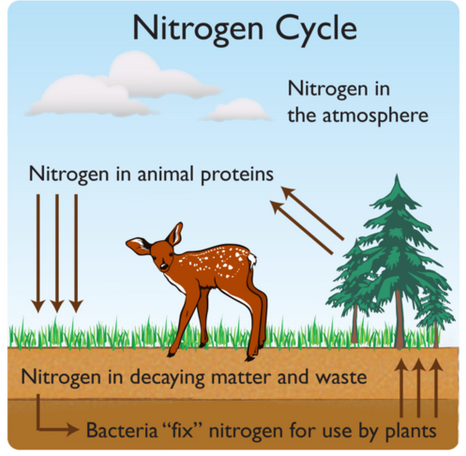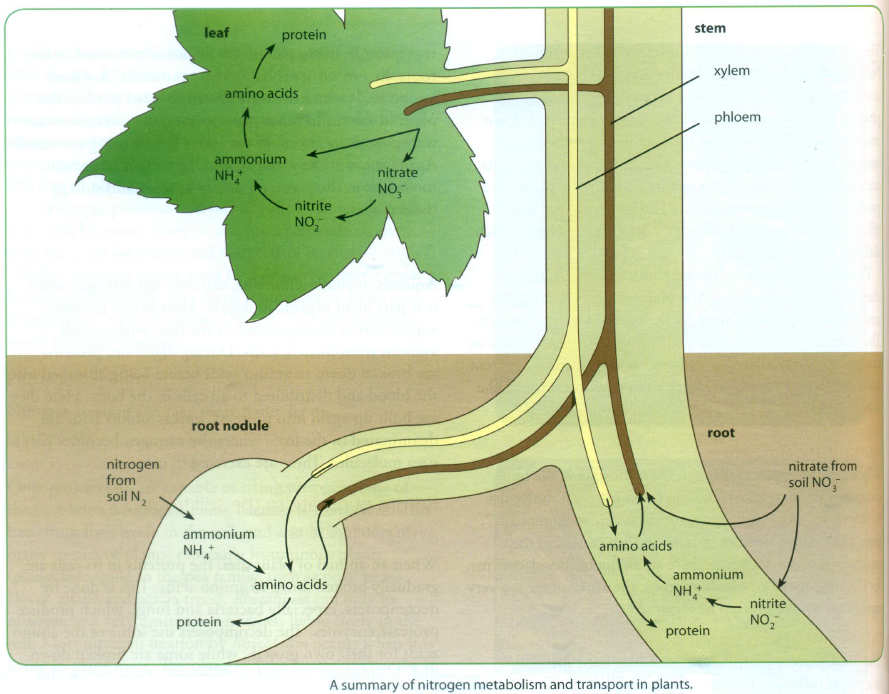Biology
 Living organisms need nitrogen because nitrogen atoms are an essential part of proteins, nucleic acids and ATP. The air contains about 78% nitrogen gas. However, this is in the form of nitrogen molecules, in which two nitrogen atoms are held together by a very strong triple covalent bond. This is very unreactive.
Living organisms need nitrogen because nitrogen atoms are an essential part of proteins, nucleic acids and ATP. The air contains about 78% nitrogen gas. However, this is in the form of nitrogen molecules, in which two nitrogen atoms are held together by a very strong triple covalent bond. This is very unreactive.
Nitrogen molecules freely diffuse in and out of the bodies of living organisms, but take no part in the metabolic reactions inside their cells.
Nitrogen fixation
For nitrogen to become involved in metabolic reactions, it must first be converted to a different form by combining with oxygen or hydrogen. This process is called nitrogen fixation. It can be done by:
? Lightning, which provides very high temperatures that can cause nitrogen and oxygen molecules in the air to combine to form nitrogen oxides; these can then be washed to the ground in rain.
? Industrial processes in which nitrogen is combined with hydrogen to produce ammonia, NH3; this is then used to manufacture fertilisers such as ammonium nitrate.
? Nitrogen-fixing bacteria, which use the enzyme nitrogenase to combine nitrogen and hydrogen to produce ammonium ions. Some of these bacteria live free in the soil, lakes or oceans. Others, for example Rhizobium, live symbiotically in root nodules in several different species of plants, particularly legumes such as peas and beans.
Formation of amino acids
Plants are able to take nitrate ions, N03-, or ammonium ions, NH4+, from the soil into their root hairs. This may be done by diffusion or active transport. These ions can be combined with carbohydrates to produce amino acids.
Consumers obtain their nitrogen by eating proteins and other nitrogen-containing organic compounds that were originally synthesised by plants.

Decay and ammonification
Animals excrete nitrogen-containing compounds such as ammonia and urea. When they die, protein molecules in their bodies are broken down by enzymes produced by bacteria, fungi and other decomposer organisms. These processes add ammonia and ammonium ions to the soil.
Nitrification
Nitrifying bacteria oxidise ammonia to nitrate ions. This is done in two stages:
? Nitrosomonas oxidises ammonium ions to nitrite ions, N02-;
? Nitrobacter oxidises nitrite ions to nitrate ions, N03-.
The nitrate ions can then be taken up by plant roots.
Denitrification
Several different types of bacteria get their energy by converting nitrate ions to nitrogen gas. This process is called denitrification, and it returns nitrogen gas to the atmosphere.


- Ecology
Ecology Webquest Name: __________________________ Period: ________ Date: _____ Part I: Ecosystems and Nutrient Cycling I. FOOD CHAINS http://www.ecokids.ca/pub/eco_info/topics/frogs/chain_reaction/index.cfm and click on ?play the game? to begin. Answer...
- # 67 Summary Of Ecology
1 A habitat is a place where an organism lives. The niche of an organism is the role that it plays in the community.2 A population is a group of organisms of the same species, living in the same place at the same time, that can interbreed with one another....
- #64.1 Ecology Syllabus 2015
? Levels of ecological organisation ? Energy flow through ecosystems ? Recycling of nitrogen Learning Outcomes Candidates should be able to: (a) define the terms habitat, niche, population, community and ecosystem and be able to recognise examples...
- Photosynthesis And Cellular Respiration
Photosynthesis is the processes of converting carbon dioxide and water, using light energy, into glucose and oxygen. Plants, algae, and certain prokaryotes capture about 1% of the energy in the sunlight that reaches Earth and convert it to chemical energy...
- Argon (ar)
Term: argon (Ar)Literally meaning: ?slow?Origin: Anc Greek'á??ü? < 'á???ü?(=lazy, idle, not working the ground, living without labor) Coined/History William Ramsey (1852-1916) The name is a reference to the fact...
Biology
# 66 The nitrogen cycle

Nitrogen molecules freely diffuse in and out of the bodies of living organisms, but take no part in the metabolic reactions inside their cells.
For nitrogen to become involved in metabolic reactions, it must first be converted to a different form by combining with oxygen or hydrogen. This process is called nitrogen fixation. It can be done by:
? Lightning, which provides very high temperatures that can cause nitrogen and oxygen molecules in the air to combine to form nitrogen oxides; these can then be washed to the ground in rain.
? Industrial processes in which nitrogen is combined with hydrogen to produce ammonia, NH3; this is then used to manufacture fertilisers such as ammonium nitrate.
? Nitrogen-fixing bacteria, which use the enzyme nitrogenase to combine nitrogen and hydrogen to produce ammonium ions. Some of these bacteria live free in the soil, lakes or oceans. Others, for example Rhizobium, live symbiotically in root nodules in several different species of plants, particularly legumes such as peas and beans.
Formation of amino acids
Plants are able to take nitrate ions, N03-, or ammonium ions, NH4+, from the soil into their root hairs. This may be done by diffusion or active transport. These ions can be combined with carbohydrates to produce amino acids.
Consumers obtain their nitrogen by eating proteins and other nitrogen-containing organic compounds that were originally synthesised by plants.

Animals excrete nitrogen-containing compounds such as ammonia and urea. When they die, protein molecules in their bodies are broken down by enzymes produced by bacteria, fungi and other decomposer organisms. These processes add ammonia and ammonium ions to the soil.
Nitrification
Nitrifying bacteria oxidise ammonia to nitrate ions. This is done in two stages:
? Nitrosomonas oxidises ammonium ions to nitrite ions, N02-;
? Nitrobacter oxidises nitrite ions to nitrate ions, N03-.
The nitrate ions can then be taken up by plant roots.
Denitrification
Several different types of bacteria get their energy by converting nitrate ions to nitrogen gas. This process is called denitrification, and it returns nitrogen gas to the atmosphere.


Syllabus 2015 (d) describe how nitrogen is cycled within an ecosystem, including the roles of nitrogen-fixing bacteria (e.g. Rhizobium) and nitrifying bacteria (Nitrosomonas and Nitrobacter); (e) use the knowledge gained in this section in new situations or to solve related problems. Note: An ecosystem should be studied in relation to an area familiar to the candidates. |
- Ecology
Ecology Webquest Name: __________________________ Period: ________ Date: _____ Part I: Ecosystems and Nutrient Cycling I. FOOD CHAINS http://www.ecokids.ca/pub/eco_info/topics/frogs/chain_reaction/index.cfm and click on ?play the game? to begin. Answer...
- # 67 Summary Of Ecology
1 A habitat is a place where an organism lives. The niche of an organism is the role that it plays in the community.2 A population is a group of organisms of the same species, living in the same place at the same time, that can interbreed with one another....
- #64.1 Ecology Syllabus 2015
? Levels of ecological organisation ? Energy flow through ecosystems ? Recycling of nitrogen Learning Outcomes Candidates should be able to: (a) define the terms habitat, niche, population, community and ecosystem and be able to recognise examples...
- Photosynthesis And Cellular Respiration
Photosynthesis is the processes of converting carbon dioxide and water, using light energy, into glucose and oxygen. Plants, algae, and certain prokaryotes capture about 1% of the energy in the sunlight that reaches Earth and convert it to chemical energy...
- Argon (ar)
Term: argon (Ar)Literally meaning: ?slow?Origin: Anc Greek'á??ü? < 'á???ü?(=lazy, idle, not working the ground, living without labor) Coined/History William Ramsey (1852-1916) The name is a reference to the fact...
